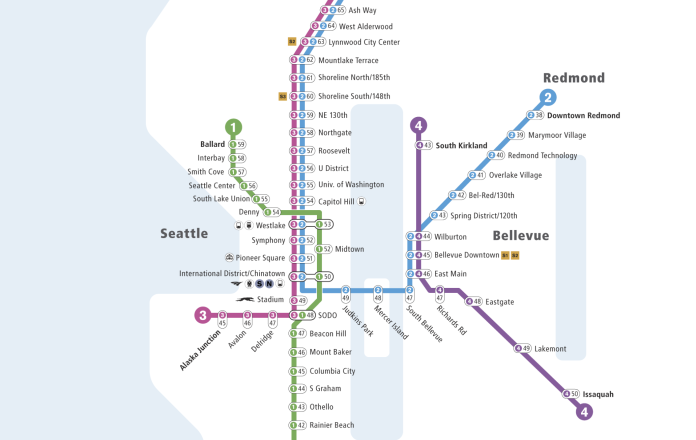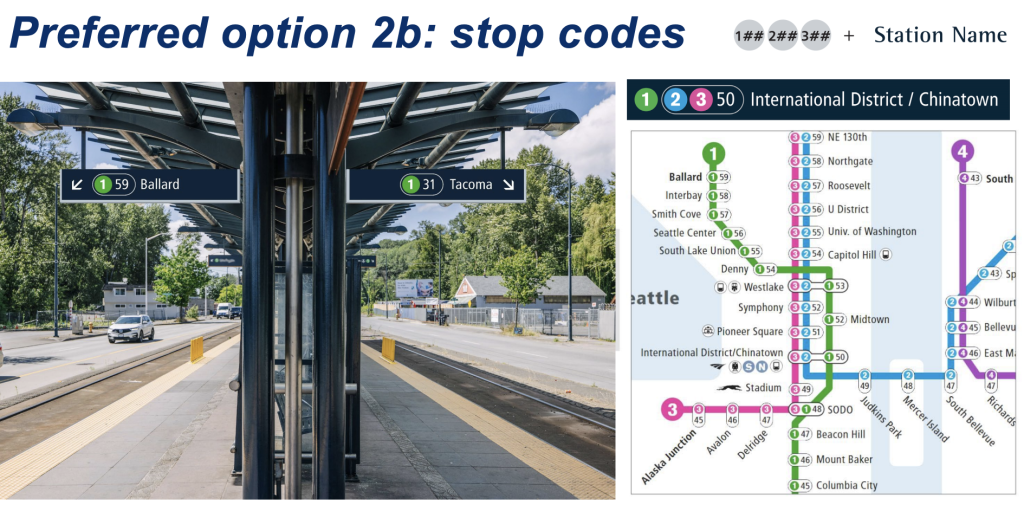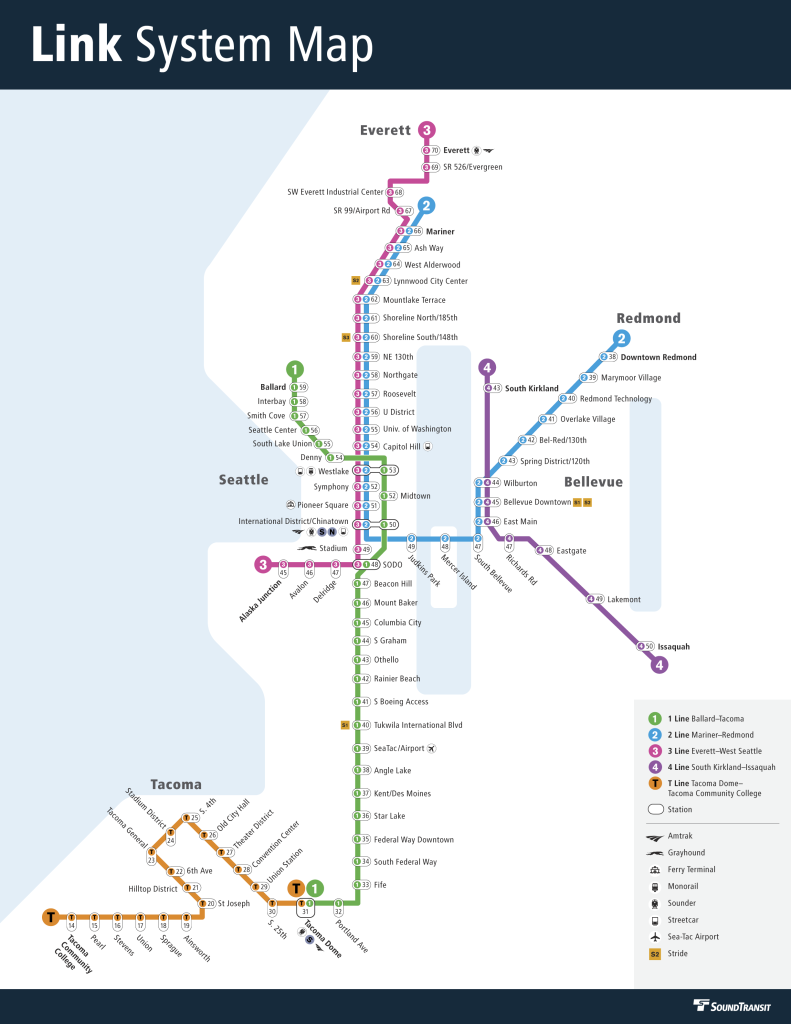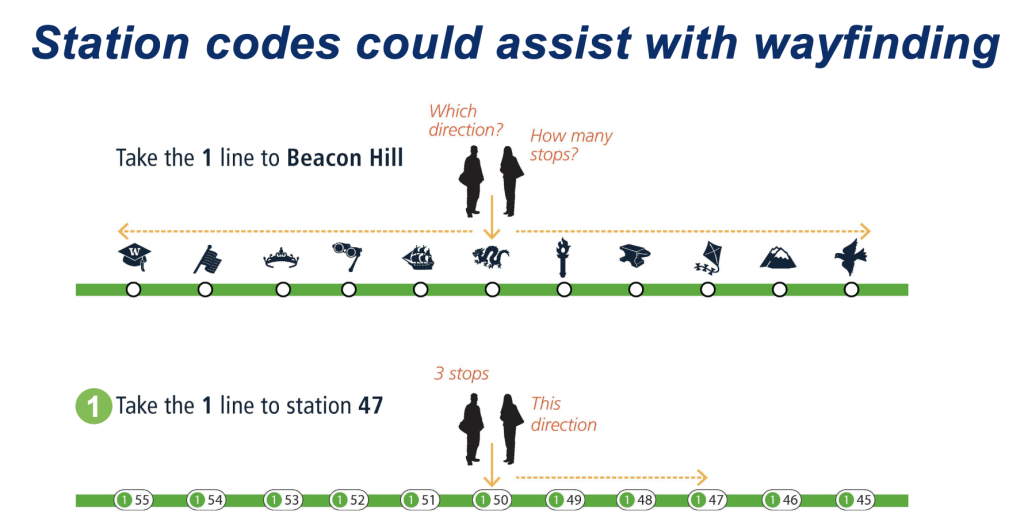
Sound Transit will deploy a new station code system across the Link network for navigation much like sequential numbering systems used for airport gates and major train station tracks and platforms. These will supplement regular station names, not replace them, but the eccentric pictograms (e.g., Roosevelt moose and Capitol Hill pride flag) found in the system will be retired. This decision follows a summer of testing and rider engagement that focused on three different station code design options.
Though virtually non-existent in North America, station code systems are widely popular in Asian metro systems like Seoul, Tokyo, and Bangkok and are generally seen as a helpful tool by foreigners and locals alike.
Last week, agency staff briefed Sound Transit boardmembers on the need for the changes and a preferred approach that will be rolled out in Link system expansions on the horizon. Sound Transit staff are trying to address some unique problems with the change, which boil down to usefulness, scalability, and meeting legal requirements.

Under state law, Sound Transit is required to use some form of alternative station identification for Link. The agency is mandated to incorporate signage into stations “that is easily understood by the traveling public, including, but not limited to, persons with disabilities, non-English-speaking persons, and visitors from other nations.” The law also specifically states that signage “use distinguishing symbols or pictograms developed by the authority as a means to identify stations and may identify points of interest along the corridor for persons who use languages that are not Roman-alphabet based.” Understandably, many people who don’t speak and read English may find identifying stations only by Roman-alphabet characters in English difficult if not impossible (even if they read and speak in another Roman-alphabet language), which is why another method of station identification is important.
According to engagement results, pictograms are neither popularly used nor highly useful among surveyed Sounding Board members and limited-English proficiency (LEP) focus groups. Less than 20% of Sounding Board members and less than 10% of LEP participants said that they use pictograms. Worse, most participants — including three-quarters of the target audience (LEPs) — said that they did not find pictograms helpful. Conversely, most participants said that station codes were useful and gave incredibly high marks in intuitiveness (75% to 80%), helpfulness (78% to 90%), and ease of use (75%). In fact, participants inn the LEP focus groups quickly picked up on how the maps worked and were able to make successful transfers in travel scenarios using station codes. Among people with visual disabilities, there wasn’t as clear a preference for approaches, but Sound Transit did receive strong feedback on using a braille format on tactile signage that would be very clear about the information being presented.
For Sound Transit, ditching the pictograms for station codes also makes a lot of visual and physical communication easier. Creating pictograms can be a fraught process and they become increasingly complicated to devise with unique, identifiable characters for a vastly growing system. Arabic numerals, on the other hand, are straightforward, scalable as lines are added and extended, and fit more neatly into maps and other media. Sound Transit will keep universal icons in its media and signage like airplanes and ferries for airports and ferry terminal connections.

Based upon feedback, Sound Transit’s preferred approach is Option 2B, a bubble system that gives each station one to three stop codes. Each code is a three-digit number with the first number identifying the line serving the station and the last two digits specific to a station. The latter two numbers can also be thought of as a base number. For instance, Northgate would get the base number of 58 and will be served by the 2 and 3 Lines. Therefore, the station would have two stop codes: 258 and 358. Using three-digit numbers is an issue that the agency looked into given that the local and regional bus system often uses three-digit numbers for bus routes, so avoiding confusion is a design priority.
Because of the sequential nature of the stop code system, riders will be able to more easily navigate the direction they want to go or even know how many stops to go. On the 2 and 3 Lines, higher numbers correlate with going northbound whereas lower numbers correlate with going southbound (and eastbound or westbound where they branch). Riders can also mathematically calculate that going from stop 155 (University of Washington Station) to stop 150 (International District/Chinatown Station) will be five stops. However, the stop calculation feature does have some complexities with it since base numbers are sometimes reused by entirely different stations or are skipped in certain circumstances by branch lines. The numbering plan is centered on the regional hub station: International District/Chinatown Station.
A big question is whether or not Tacoma’s T Line streetcar will get station codes. Agency staff said it’s not required for the line and pictograms are not currently used on it, but the design concepts did build in potential for the line to work seamlessly with the 1 Line.
Riders can expect to see station codes rolled out and pictograms removed in the upcoming East Link and Lynnwood Link expansions. Those project openings are trending to late 2024 due to construction delays, but there are efforts for a partial East Link opening next year and the idea has support from Claudia Balducci (Sound Transit boardmember and chair of the Systems Expansions committee) and interest from Sound Transit CEO Julie Timm.
Stephen is a professional urban planner in Puget Sound with a passion for sustainable, livable, and diverse cities. He is especially interested in how policies, regulations, and programs can promote positive outcomes for communities. With stints in great cities like Bellingham and Cork, Stephen currently lives in Seattle. He primarily covers land use and transportation issues and has been with The Urbanist since 2014.


